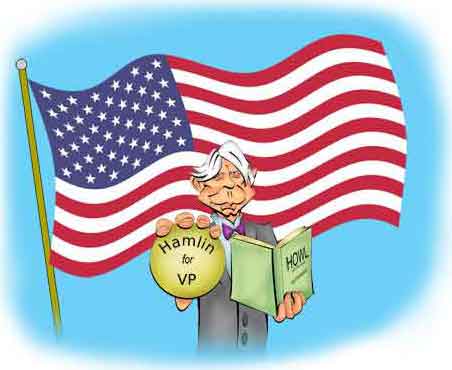Carl Sandburg
The King
|
Carl Sandburg |
||||
Today you might find historians who go into spittle flinging diatribes when you mention Carl Sandburg's books about Abraham Lincoln, The Prairie Years and The War Years. Huh! Call that history? No references. Anecdotal stories. Invented quotes. Even invented thoughts, for crying out loud! And for that, Carl won a Pulitzer Prize for History?
Oh, give Carl a break! say his friends. This multi-volume oeuvre - two volumes for The Prairie Years and four for the The War Years - were a popular history. It was intended to be read by your average Joe and Josephine Blow who don't want to plough through a text peppered with superscripts for eentsy-lettered footnotes pointing to references that no one except eggheads would read anyway.
And like the good scholar he was, Carl himself was not above self-criticism. When the final volumes were published he wrote Franklin Roosevelt - who was then the President of the United States. He said that looking back on the books, he thought they seemed to be like memorandum for his own use.
Certainly it's true that the books are filled with minute detail on episodes that most readers think could have been edited out. But on the other hand the biography does take up six volumes and over 2400 pages. So Carl had to put in some detail.
Despite the judgement of the academic historians, the influence of Carl's book is not to be denied. Because of the memoranda-like organization and the sheer volume of the information, the biography comprises a compendium of episodes in Lincoln's life that provide much fodder for research. You can have a lot of fun trying to verify (or refute) Carl's accounts. So many an assistant professor has much to thank Carl for.
Carl's Pulitzer Prize - for 1940 - wasn't the first time Carl had won the award. He picked up the prize in 1919 and would win again in 1951 (both were for his poetry). But in the late 19th century if there was someone you would think would not become a treble Pulitzer winner, it was Carl Sandburg2.
Footnote
Carl won two Pulitzer Prizes outright - the one in 1940 for the Lincoln biography and the other in 1951 for the publication of Collected Poems. In 1919, the poetry prize was shared by Carl for his book Cornhuskers with Margaret Widdemer for "Old Road to Paradise".
Meet Carl Johnson - uh - Sandburg
Carl Sandburg was born in 1878 in Galesburg, Illinois, and became what is arguably one of the last of an increasingly endangered species. That's the celebrity author. In other words, Carl was an author that became a celebrity and not a celebrity who later became an author.
Yes, yes, we know that there are a number of authors who are household names. Today, though, these tend to be writers of "popular" genre, most notably fantasy, horror, and science fiction. Such authorship can be an honorable calling, true, but there has always been a low-brow taint for books that are written primarily to entertain. The Pulitzer or Nobel Prize Committees are supposed to select works that are high minded, elevated, and of - quote - "ideal tendencies" - unquote. Naturally such "ideal" books become incredibly dated after a few years and less and less read.
Although Carl is mostly thought of as a poet, he published a lot of prose as well. These books included Storm over the Land, Home Front Memo , Remembrance Rock, Mary Lincoln: Wife and Widow, Lincoln Collector, Always the Young Strangers, A Lincoln Preface, and of course, Abraham Lincoln: The Prairie Years and the War Years.
Carl also wrote children's books. These were Rootabaga Stories, Rootabaga Pigeons, Abe Lincoln Grows Up, Early Moon, Potato Face, Prairie-Town Boy, Wind Song, and The Wedding Procession of the Rag Doll and the Broom Handle and Who Was in It.
Of course, there was Carl's poetry: In Reckless Ecstasy (his first collection), Incidentals, The Plaint of the Rose, Chicago Poems, Cornhuskers, Smoke and Steel, Slabs of the Sunburnt West, Bronze Wood, Poems of the Midwest, The Complete Poems of Carl Sandburg (which got the Pulitzer), Harvest Poems, Six New Poems and a Parable, and Honey and Salt.
Less easily classified - whether it's supposed to be poetry or prose is semantical - are The American Songbag and it's sequential volume The New American Songbag. After Carl died there were other editions and collections issued.
You'll read that Carl's childhood was one of poverty. That's true enough, but he and the family weren't starving to desperation either. So it's kind of hard to say if they were poor or if they were just middle class in a place where the middle class didn't have much money. Probably the best description is the Sandburgs were what sociologists call the working poor.
Carl's folks, August and Clara Johnson, were Swedish immigrants. Yes, we said August and Clara Johnson. When August started working for the railroad he found that there were too many Johnsons around - and there were even some other August Johnsons. So he decided to use the name Sandburg.
August was a blacksmith, a craftsman whose skills were necessary for keeping the railroads up and running. The rail industry was high tech and provided steady work for its support staff but not much money. Of course, August had to provide for seven kids which took up a good chunk of the family's income.
You may read that Carl dropped out of grade school, but that's not exactly true. The reason some people think Carl dropped out when he was so young is that grammar school today is equated with grade school. That is grades 1 - 6 or today usually grades 1 - 5. Instead Carl's grammar school included grades 1 - 8 (up through middle school) and he quit school in the eighth grade.
Carl's education was not that deprived for a late 19th century or even early 20th century kid. A good chunk of people began work at age 14 or even earlier. So a lot of people, sometimes even from fairly well off familes, went no higher than the eighth grade.
The 19th century was an era when there was a distinction between having an education and having gone to school. Even some professionals such as physicians and surgeons might obtain their skills through apprenticeships rather than book learning. A person could be well-educated and have little formal schooling.
The Student
That said, from Carl's catholicity of jobs - shining shoes, washing dishes, delivering milk, selling newspapers, laying bricks, harvesting wheat - it was clear that he was not ready to settle on a career. So when he was 18 he decided to head out into the wide world. His dad, as a railroad employee, was able to finagle his son a train pass to Chicago3.
Footnote
Usually railroad employees were able to get free passes. One young man who took advantage of this perk was a telegrapher who lived in Oklahoma and who had aspirations of getting into show business. So Gene Autry used his railroad pass to travel to New York where he auditioned for the recording companies. As we know, this was a pass well used.
Carl liked Chicago. It was a big place and it served as the hub for the center of the country. Carl worked at a number of jobs and then began to spread out into the rural Midwest. That is, he became a hobo.
You see, times were not good. In fact the country was just emerging from the "Panic of 1896". This was a short albeit sharp economic depression which left a number of men and boys roaming the country looking for work.
So just what do the politicians do when times get tough? Why, start a war, of course.
In 1898 for reasons which are straightforward in events if not clear in interpretation, America declared war on Spain. What really got the ball rolling was that many Americans thought Spain blew up the Battleship Maine in Havana Harbor. "Remember the Maine! To H[eck] With Spain!" became the rallying cry.
Carl returned to Galesville and on April 26 signed up with Company C of the Sixth Infantry of the Illinois Volunteers4. He shipped out and although they stopped briefly at Cuba they were ultimately stationed in Puerto Rico. Company C saw minimal action if any and it was hot and uncomfortable. But in the end the hassles were worth it. When Carl was discharged he found his hometown college, Lombard, had granted him a scholarship.
Footnote
There was not yet a massive standing US army. So as was done during the Civil War when troops were needed the states provided the muster. The standing army as we know it today only arose with World War II.
Today it seems strange that a grammar school dropout could simply enroll in college. But colleges were moving away from being affectations for rich kids who spent their secondary school years studying Latin and Greek. Instead they were becoming (or at least hoped to become) institutions that taught marketable skills and strove to generate new knowledge. Also with the advent of land grant colleges and an increasing competition for students, entrance requirements had become more flexible5. Schools were even accepting students with little previous education on the proviso that deficiencies could be made up after enrollment. In short, as long as you could convince a college to let you in, you could get in.
Footnote
Actually admission requirements for the early colleges were never quite as rigid as some think. At that time there were no standardized entrance examinations like the SAT or ACT. Instead each college would give their own entrance tests. But the tests were - as some colleges themselves admitted - "flexibly graded". Naturally we must be forgiven for suspecting the flexibility increased with the income of the students' parents.
Carl must have been a good student as well as a good soldier. After his first year, he garnered an appointment to West Point. However, he didn't pass either the math or grammar (!) entrance exams. So back to Lombard he went.
While in college Carl began showing interest in writing poetry. In 1902 he had his first verses published in a magazine called The Thistle. Two years later one of his professors, Philip Green Wright, even put up the cash to publish Carl's first poems in a small booklet titled Reckless Ecstasy. Circulation, of course, was limited.
Carl the "Economic Democrat"
In 1907, Carl left Lombard without taking a degree. But attending college at all was enough of a rarity that it created credentials that could open doors to better employment. Carl moved to Milwaukee.
The move was not just to get to a bigger city to find work. For that he could have headed back to Chicago. Instead Carl moved to the City that Schlitz6 Made Famous because he had become interested in politics. Specifically he had been working for the mayoral campaign of Emil Seidel, the candidate for the Social Democratic Party.
Footnote
The story of how Schlitz went from the Beer that Made Milwaukee Famous and was the #1 best selling beer in the nation to a brew that nobody drank is worth a moment's pause that refreshes. In the 1970's in an effort to cut cost and raise profits, the president of the company decided to speed up the brewing process and so produce more Schlitz in less time. He did this by changing both the ingredients and the process.
The changes were done gradually in the hopes that any differences, particularly in taste, would slip by unnoticed. However, the changes were not gradual enough and consumers are sensitive to differences from their expectations.
There were other undesirable effects other than just a change in flavor. For one thing the beer went "off" sooner than the earlier product. There were also problems in the appearance - at one point there were small amounts of precipitates which varied from batch to batch and bottle to bottle (one of the consumers said he opened a bottle and saw something that looked like snot). Despite assurances that the precipitate was not of any health concern (which was true) and the problem was soon fixed, enough customers had switched brands that the company lost most of their business and Schlitz disappeared from the shelves.
The brand was bought by Stroh Brewers and finally by Pabst. After reconstructing the original formulation and process - the recipe evidently got lost along the way - Pabst reintroduced Schlitz in 2009 assuring the public that it is the traditional formula. Alas, although Schlitz remains available, the Beer has not made Milwaukee famous again.
Of course everyone knows the story of how there was a baseball pitcher named Milton Famey who loved Schlitz beer. Mil - as he was called - was once taken to a bar by the members of an opposing team. They treated him to generous portions of Schlitz and so he was in poor shape by game time.
Mil couldn't throw a pitch and he walked every batter who stepped up to the plate. After Mil lost the game the other team was in the locker room drinking toasts to "Schlitz".
A reporter came in and asked, just who was this "Schlitz"? Was he a player? Or a manager?
"No", the team members said. "'Schlitz' is the beer that made Mil Famey walk us."
Ho! Ho! people say. We knew it. So Carl was a bleeding heart liberal. Not just a liberal but like all intellectuals he was probably a socialist and maybe even a Commie. What could you expect for someone who liked poetry?
Pshaw, say Carl's fans. Carl was nothing of the sort. True, today socialism has fallen from favor to the point that a famous socialist society now calls itself a "think tank" and on their website the word "socialist" appears only once and "socialism" not at all. And modern socialistic governments - whether successful or not - are often labeled something else.
Before 1917 socialism was not just an epithet that politicians hurl at each other when they don't have any real issues to discuss. Socialism was simply a political and economic philosophy whose advocates did not necessarily refute free enterprise and capitalism. There were many flavors of socialists.
Certainly unlike Marxists, socialists did not necessarily promote abandonment of traditional religions for dialectical materialism (whatever that is). In fact, from 1911 to 1917, George Lunn, the socialist mayor of Schenectady, New York, was a minister of the Dutch Reformed Church.
But Vladimir Ulyanov - known better as Nikolai Lenin - and his buddies had created such a negative picture of socialism that in America many socialists began jumping ship. In 1917 George quit being a socialist, knowing he couldn't get elected with such a label. So he switched to being a Democrat. Americans began seeing the Bolsheviks less as a party advocating better working conditions and fair wages, but as a subversive force working against freedom and American values.
Carl's socialism, his friends say, was of this early American variety. Carl? An advocate of nationalizing industries or doing away with private businesses? A proponent of government controlling the economy, exchange rates, and prices?
How ridiculous! How absurd! No, Carl simply felt that the effort workers put in merited them sufficient pay so they didn't have to struggle to live.
That's the kind of - quote - "socialist" - unquote - Carl was.
Inte sant?
Weeeeeheeeeellllll, not quite. The picture of Carl and his politics is a bit more, well, we'll call it more complex. And we might as well start our discussion with one of Carl's early poems "The Dynamiter" which was published in 1914.
Here Carl writes of a meeting in a tavern with someone he calls a "dynamiter". He paints a picture of a rather boisterous and cheerful man with a wife and children but who was involved in opprobrious activities.
Yes, his laugh rang like the call of gray birds filled with a glory of joy ramming their winged flight through a rain storm.
His name was in many newspapers as an enemy of the nation and few keepers of churches or schools would open their doors to him.
Carl finishes the poem in what can only be called a positive light:
Only I always remember him as a lover of life, a lover of children, a lover of all free, reckless laughter everywhere - lover of red hearts and red blood the world over.
A little explanation is in order. At 1 o'clock in the morning on October 1, 1910, a dynamite bomb exploded in an alley behind the building housing the Los Angeles Times. The paper had taken a strong editorial position against the increasing unionization of the labor force. Specifically, it had supported the state government breaking up strikes of iron workers with strong arm tactics. And we mean strong arm tactics.
Witnesses told of two explosions. There was first a smaller one that was followed by a larger blast that engulfed the building in flames. Twenty-one men died and over one hundred were injured.
Two men were arrested for the crime. One was John J. McNamara, a member of the International Association of Bridge and Structural Iron Workers. The other was his brother James. Both men were defended by Clarence Darrow, the famous attorney of the underdog.

Clarence Darrow
Attorney of the Darned
Although the supporters of the McNamaras assumed the charges were a frame-up, Darrow soon found clear cut evidence of his clients' guilt. Knowing the prosecutors had the same evidence, Darrow realized the only way to save the men from conviction and execution was a plea deal.
After much hesitation, John finally agreed to plead guilty to ordering the bombing and James would admit he was the one who actually planted the bomb. They were permitted to make statements in mitigation where they said that the bombing had been intended as a scare tactic and there was no intent to cause harm to the employees. Instead the detonation had accidentally set off a gas explosion that had destroyed the building and caused the casualties. John received life in prison and James got 15 years.
"The Dynamiter" - as Carl later said - was based on a real conversation with the well-known labor organizer Anton Johannsen who Carl knew well. Anton had in fact been indicted as an accessory to the McNamaras' bombing.
However, Anton doesn't really fit the picture of the dynamiter of Carl's verse. The charges against Anton were dropped and there was no evidence he was involved. He kept working in the labor movement for many years afterwards.
Instead it's more likely that Carl was thinking of a man named Matthew Schmidt. Matthew - called Smitty by his friends - was an advocate of violent anarchism and had helped the McNamaras obtain the dynamite for the Times bombing.
Smitty was later arrested in New York and in 1915 was convicted of murder for the bombing7. After serving 30 years of a life sentence he was paroled and died in 1950.
Oh, yes. Smitty was a friend of Carl's. They continued to correspond even after Smitty was in prison.
Footnote
Strictly speaking Matthew Schmidt was convicted of a single count, the murder of the LA Times pressman, Charles Haggerty.
Carl knew that being too outspoken for minority political views was not always prudent for someone who was entering the public eye. So of the forty-one articles he wrote for the International Socialist Review, only eight were printed with his name. The rest were either anonymous or under pseudonyms.
But still we wonder? What type of politics did Carl expound? Was he really for the let's-get-along-and-work-together  way?
way?
Well, if you go to Carl's writings he makes his position clear:
That piece of paper called the Constitution of the United States is some joke. It was made of men against dollars. It is used for dollars against men.
As far as whether Carl was really for no-if-ands-or-buts socialism to cure the country's ills, he didn't waffle about it. In one article following the mayoral elections, he wrote:
"HALLELUJAH!"
By Carl Sandburg
Milwaukee, the largest American brewing center, has gone Socialist.
Berkeley, a leading western educational center, the seat of the University of California, has gone Socialist.
Butte, Mont., sometimes called the ugliest and wickedest city in the United States, has gone Socialist.
Schenectady, almost within human eyesight of the tall buildings of Wall Street, has gone Socialist.
Los Angeles, the wealthiest and most beautiful of American cities, is about to tumble into the possession of the Socialists.
Labor is learning how to fight. Labor is finding its power.
Any Socialist who so chooses, has a right to now lift his voice and cry out loudly,
"HALLELUJAH!"
Hm. That's the trouble with Carl. You just couldn't get him to say what was on his mind.
But, but, you say. Carl was talking about the outcomes of free and fair elections. So clearly he felt the way to progressive programs was - as we say - working "within the system?"
Well, let's look at what Carl said about handling disagreements twixt the factions. In doing so, Carl brought up the proposal of Teddy Roosevelt (yes, the President) that all men should be trained for military service as in Switzerland. But Carl's agreement was less for the country to have a standing army than for the perk that the Swiss government gave each able bodied man a rifle.
Now Carl didn't think much of the egg-headed golden-spoon-in-the-mouth resident of the White House "It's hard to say yes to anything coming from the horse-teeth patriot and politician from Oyster Bay", Carl snorted. But he added if every one had a gun, then
Every striking workingman under these conditions will be more dangerous to scabs, strikebreakers, gunmen, and thugs than now.
So it seems that Carl, at least in the years around World War I, could be quite the firebrand. From his articles we do not see the mild-mannered Optimist of the Greatness and Future of America. Instead there emerges a rabid near militaristic socialist who felt that the United States had completely failed in its promise and was beyond repair. The only way conditions could be improved for the poor - a much larger chunk of the population than now - was for America to fall.
Like many American socialists, Carl was watching the events of the Russian Revolution with interest. Between 1918 and 1922 Russia had not yet emerged as the personal property of Joseph Stalin. The Russian Constitution stated there was to be freedom of speech, religion, and conscience. Throughout the civil war between the "Whites" and the "Reds", the Bolshevik's were trying to paint a picture that they were the best friends the American workingman would ever have. How it would turn out was by no means clear although the murder of Czar Nicholas and his entire family - including their dog - was a hint.
Even after the Czar was, ah, "taken care of", Carl was willing to work closely with the newly emerging Soviet government. In November 1918, Carl had traveled to Sweden, and on a park bench in Stockholm, he met a Russian who handed him a pamphlet written by Lenin. Carl took the book, A Letter to American Working Men, and brought it back for publication. This story of Carl being a surreptitious courier for the Russians only came to light with the sale in 2001 of some of his recently discovered manuscripts.
From Socialiste to Journaliste
In Milwaukee Carl wrote articles and gave speeches for the socialist cause. His diligence had its rewards and Emil was elected mayor. So from 1910 to 1912 Carl served as his secretary.
As private assistant to the mayor, Carl's remuneration was adequate but not opulent. So to pick up additional cash he wrote for local newspapers, the Social-Democratic Herald, the Milwaukee Leader as well as the Milwaukee Journal, the Milwaukee Daily News, and the Milwaukee Sentinel. He was also a frequent contributor to The Day Book, a newspaper that provided ad-free reading to its subscribers (it went bust in a few years).
But all was not work for Carl. At one of the party meetings in Milwaukee he met a young woman named Lilian Steichen. And yes, she was the sister of famed photographer Edward Steichen. In 1911 she and Carl were married and when Emil's term as mayor ended, Carl and Lilian (called Paula by her friends) moved to Chicago.
Back in the Windy City, Carl was now an experienced journalist. He wrote for a number of publications, including the Chicago Daily News. Among his most notable articles were a series about the Race Riots of 1919.
Carl had actually been reporting on the deepening divides between the black and white communities before. More and more African Americans had been moving North, and as the black population of Chicago increased most had moved into the areas around the center city. The increasing population put pressure on the surrounding neighborhoods and expansion began pushing blacks into what were traditionally white areas.
The spark that ignited the riots was when an African American teenager, Eugene Williams, was swimming in Lake Michigan. Although there was no legal segregation, it was understood that the races were to stay on separate sections of a beach. But when Eugene inadvertently strayed across the "line", he was struck by rocks thrown by white bathers. He slipped under the water and drowned.
In response to the attack on Eugene, some of the blacks had begun to hurl rocks back. What particularly angered them was that a policeman had been present but refused to take action. The violence escalated and spread into the surrounding neighborhoods.
Ultimately the deaths totaled 23 blacks and 15 whites. Mayor "Big Bill" Thompson, one of the most corrupt albeit popular mayors, did little to stop the violence. Rioting continued for a week until the Illinois governor, Frank Lowden, ordered 6000 National Guardsmen into the neighborhoods.
After the riots, the prominent civic leaders and politicians (who were white) decided the solution was simple. To prevent riots, they said, you just had to prevent any mixing of the races. So the city needed more segregation and have it enshrined in law.
During his investigation Carl not only interviewed the white civic leaders but also spoke to the city's African Americans, who had, as you might expect, had a different opinion. The problem they said was that any segregation inevitably relegated them to second class citizens.
They deserved better. Thousands of black men from Chicago had fought in World War I only to return to a segregated country with little opportunity. Carl had interviewed one African American veteran who had served in the Navy. He was fluent in English, French, German, Italian, Spanish, and Portuguese. But the only job he could find after the war was as a cook.
Carl wrote up his findings for the Daily News. He pointed out that the riots were a culmination of the tensions and violence - including the bombing of black homes and businesses - that had been growing for years. As far as a solution, Carl decided segregation of the races had to end, both in law and in practice.
The articles were noted by Joel Spingarn who was a leading officer of the National Association for the Advancement of Colored People (NAACP). Joel went to the New York publisher Harcourt Brace who agreed to issue the articles as a book. The Chicago Race Riots of 1919 was published that year.
The Poet
All the while Carl was a practicing journalist, he kept writing poems for his newspapers - yes, newspapers published poetry. He had garnered as much fame for his verse as his prose, and readers began thinking of him less as a journalist who slipped in the odd poem or two than as a poet who also wrote newspaper articles. Paula had been encouraging her husband's aspirations and in 1918, Carl had published a book of poems called Cornhuskers. As the name implies, the poems have a rural theme and it landed him the 1919 Pulitzer Prize.
Cornhuskers was actually Carl's fifth book of poems. In 1914, he had sent eight poems to Poetry: A Magazine of Verse which was edited by the poet and newspaper woman Harriet Monroe. These were collected two years later in Chicago Poems published by Henry Holt and Company8. The first poem in the collection - called "Chicago" - is the most famous.
Footnote
Cornhuskers was Carl's second mainstream collection, that is. Chicago Poems was Carl's first. Of course, he had written Reckless Ecstasy which was printed when he was in college. There were also two other early collections, Incidentals and The Plaint of the Rose, which were also printed before Chicago Poems.
Like Allen Ginsburg's "Howl", the opening lines of "Chicago" grabs attention. Years later the words - "Hog butcher for the world ... City of the big shoulders" - were used to humorous good effect in a radio skit starring long time Chicago broadcaster, Studs Terkel. In the skit Studs played Chicago detective, Lieutenant Fred Fettuccine, who was charged with enforcing "Inhibition" - the laws banning the eating of unhealthy food. Meat and other bad foods were being smuggled in by Capon's gang - Al Capon.
Soon Fred (Studs) arrested a lady for possession of onion rings. She admitted she had the contraband.
"Okay," she said. "So I got a few onions rings."
"But less than an ounce," she added. "And only for my personal use."
Carl wrote almost exclusively in free verse. This is not to be confused with blank verse. Blank verse, although eschewing rhymes, still has a meter as in Robert Frost's "Mending Wall" with its decameter lines.
Something there is that doesn't love a wall
That sends the frozen-ground-swell under it,
And spills the upper boulders in the sun;
And makes gaps even two can pass abreast.
But free verse eschews rhyme and meter and virtually anything else.
you once promised me
an eternity.
but the curtain closes,
tortured,
silent,
There is only belligerence,
only a memory.
Curmudgeons often disparage free verse since it seems the antithesis of poetry. After all, if poetry is a work of literature with rhyme or meter how do you even define poetry if you have neither? Anyone can write free verse, they say, and point out the sample above was not by Carl. Instead it was generated by a computer.
The lines in free verse are determined by the type of rhythm the poet wants and to add emphasis to certain words and phrases. In some cases free verse can read more poetical than blank verse with its enforced meter.
Why were Carl's poems so popular with the public? Critics can give their explanations, but one that they often miss is the most obvious. Carl's poems are inevitably brief - as you would expect for poetry that often found its way into newspapers and magazines. So the readers were spared the sheer drudgery that they encountered when trying to wind their way through the "good" poems of Henry Wadsworth Longfellow ("Evangeline" and "Song of Hiawatha"), Alfred, Lord Tennyson ("Idylls of the King"), and John Milton ("Paradise Lost").
The Beats
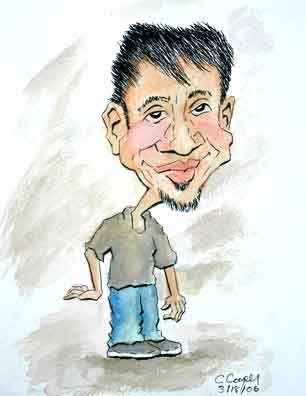
How did Carl fare?
Carl's poems have often been compared to those of Walt Whitman. But after Carl became well-established and famous, there arose a new literary movement that was also famous for its poetry. So we naturally wonder how Carl fared with the Beats, or in common parlance, the Beatniks.

Allen Ginsberg
Influenced?
Allen Ginsberg, the most famous Beat poet, seemed to downplay Carl's influence. He knew people saw similarities between their poems. But it was really Christopher Smart, Robert Blake and Walt Whitman, Allen said, that wielded an effect on his writings.
But there was one young - ah - "beatnik9" that admired Carl. That was Robert Zimmerman, who to the surprise of many (including himself) won the 2016 Nobel Prize in Literature. But in his early days and going under his better known moniker, Bob Dylan, he was just one more of the folk-rock singers who had been springing up since the Kingston Trio showed that folk music could turn a profit.
Footnote
The term "beatnik" was in general use longer than the American collective consciousness remembers and was replaced by the word "hippie" relatively late. Although in hindsight the "Summer of Love" of 1967 was the crest of the hippie movement, in October of 1966 the term "beatnik" was still used when describing what were clearly hippies on the "Pop Art Affair" episode of The Man From UNCLE. And as late as February of 1967 - that's 1967 - none other than Hunter S. Thompson used the word "beatnik" to describe the inhabitants of the Haight-Ashbury neighborhood of San Francisco.
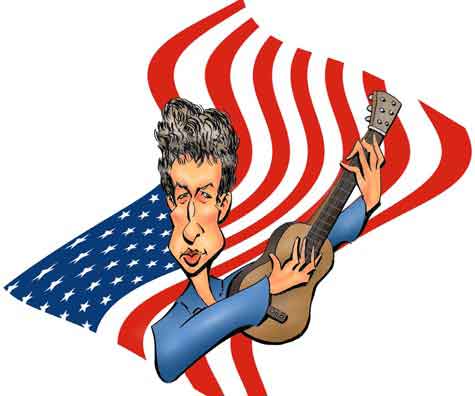
Bob Dylan
The Beatnik
In 1959, Bob had hitchhiked from his home state of Minnesota to New Jersey to meet Woody Guthrie. Although Woody was a permanent patient at a hospital due to Huntington's Disease, he and Bob developed a real rapport. So in February 1964, it wasn't a big surprise that Bob decided to make the trek to meet Carl Sandburg whose poetry he admired.
Winding his way to Asheville, North Carolina, Bob asked one of the locals if he knew how to get to Carl Sandburg's home.
"You know," Bob added, "the poet."
The man looked at the newcomer.
"Don't know about no poet," he said, "There's a Sandburg has a goat farm."
After getting directions, Bob arrived at Carl and Paula's farm. Bob knocked on the door and Carl came to the door wearing a green eyeshade. Bob introduced himself, saying he wrote poetry and adding he knew Woody Guthrie (as did Carl). He handed Carl one of his albums (by that time Bob had released three). Carl didn't seem to know who Bob was - in 1964 not that many people did - but he was polite to the young man. They sat and chatted for about half an hour before Carl rose and wished Bob well.
It may seem odd that a man who celebrated the big city had moved to rural North Carolina. Of course, by the 1960's the early American optimistic views on urbanization were pretty much gone. Times had changed. By the 1960's the cities were well into their long tortuous decline. "Bad sections" were expanding, political corruption was rampant, and young people were less than sanguine about the Wisdom of Their Elders. When Lew Welch, a "Beat" poet, wrote "Chicago Poem" he seemed to be issuing a direct rebuttal to Carl's optimistic outlook for the city and America.
The Historian
Carl's interest in the life of Abraham Lincoln was natural for a writer of issues of prejudice and racial equality. He began writing what was to be the most extensive biography of the American president in 1922. The first two volumes (The Prairie Years) were published in 1926 and were well received. But it was over a decade later that Carl completed the remaining four books, The War Years, which were published in 1939.
It's not clear how many of the people who bought the six volumes actually read them. One actually suspects that they were put on the shelf largely for decoration but not many took them down for perusal. Carl himself understood the massive undertaking reading such an olympian shelf-stuffer would be for the average reader, and he issued a one volume and heavily abridged edition in 1954.
That said, The Prairie Years and The War Years have been among the most influential biographies about Lincoln which even academics can't ignore. The books have their critics, of course, particularly since Carl did not document or footnote his sources. He also included stories which have become cemented into the popular beliefs although on further research they have little basis in fact.
One story that Carl repeated was that there was no guard at the door standing outside the presidential box at Ford's theater. This is almost uniformly believed by those who have read the popular books on Lincoln.
It is true that the policeman who accompanied Lincoln to the theater, John Parker, did not stand guard at the door as many thought he was ordered to do. However, independent eyewitnesses stated there was an attendant in a business suit at the entrance of the box.
In fact, in a letter written shortly after the assassination, one of the witnesses said he saw Booth walked to the usher and hand him his calling card. The usher went into the box and then returned and admitted Booth. So in all likelihood Lincoln himself gave Booth permission to enter.
It was not unusual that one of the most famous actors in America would be admitted to meet the president. Lincoln enjoyed the theater and liked to meet the performers. According to one account he had previously attended a play where Booth was starring and had asked to meet him. But meeting did not take place.
But who was the usher? It was probably Charles Forbes, who was employed by Lincoln as a "messenger" and was possibly a relative of Mary Lincoln.
An odd quirk of the Pulitzer Committee was that they had an understanding not to award prizes in biography for books about George Washington or Abraham Lincoln (a quirk which is no longer current). But they thought that Carl's biography merited a prize. So they finessed their own decision by giving Carl the award only for The War Years and for history, not biography.
The books sold over a million copies and in addition to solidifying Carl's reputation as a versatile man of letters, put him on a firm financial footing. He was able to spend more time at the pleasant task of lecturing about American literature. And for Carl American literature included its folk songs.
The Bard
For someone who wrote everything from children's stories to biography (one of which was about Mary Lincoln), it will be a surprise that Carl himself said he'd rather be remembered as a singer of folk songs than for his literary works. Carl had been playing guitar and singing since he was a kid. In his wandering times he picked up songs from whoever he met and when on the bum - to use a polite phrase - he would sing to entertain his fellow itinerants.
Many of the tunes found their way into his book The American Songbag. When giving lectures on poetry he would be sure to sing some of the tunes and it was inevitable that he would release an album.
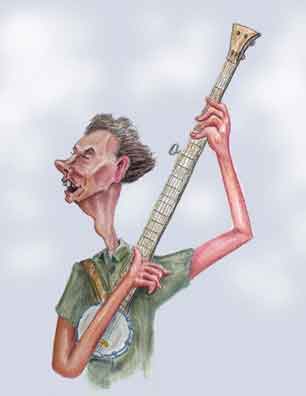
Pete Seeger ...
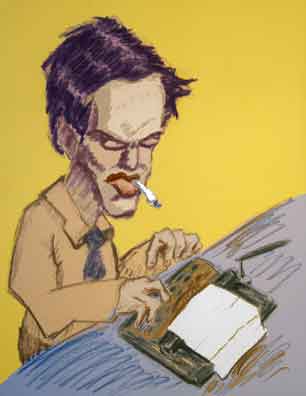
... and Alan Lomax
They liked Carl's songs.
The American Songbag was published in 1926 and was the starting place for many of the folk icons of later years. Pete Seeger said that's where he dipped for refreshment and Alan Lomax frequently cited the songs in his Folk Songs of North America.
Today some of the songs come off as dated (they are folk songs after all) and the use of dialect for the African American tunes will strike many as condescending. Nevertheless the books contain many of the earliest printings of tunes that have become performing staples.
Now we must express ourselves with complete frankness. Carl's playing will not pass muster with today's over-critical audiences. Although he sang in a pleasant and mellow baritone and despite the claim that he played guitar so well he could pass as a student of Andrés Segovia, Carl's instrumental facility remained quite rudimentary and his phrasing had a uniformity that curmudgeons will call boring. However, true folkies - such as those who enjoy Woody Guthrie and Bob Dylan - can find much merit in Carl's performances.
The Celebrity
Today when many people don't know Carl or his writings, it's worth remembering that during his lifetime he was one of America's biggest celebrities. Live stage shows were based on his writings and featured big name stars. He appeared on the covers of Life and Time magazines and yes, he showed up on (gasp!) television.
Carl's Hosts
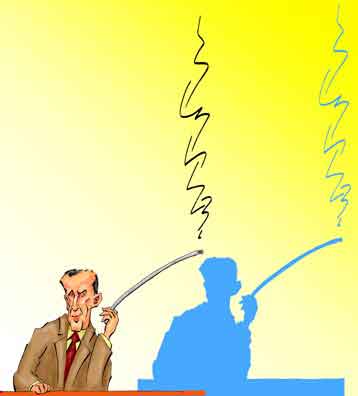
Edward R. Murrow
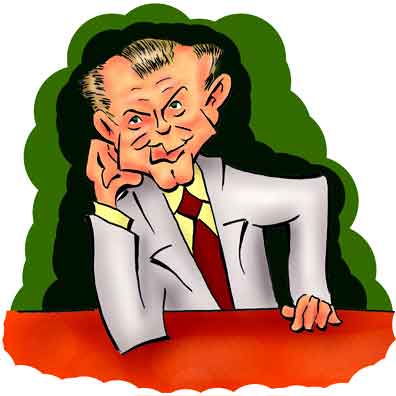
Jack Paar
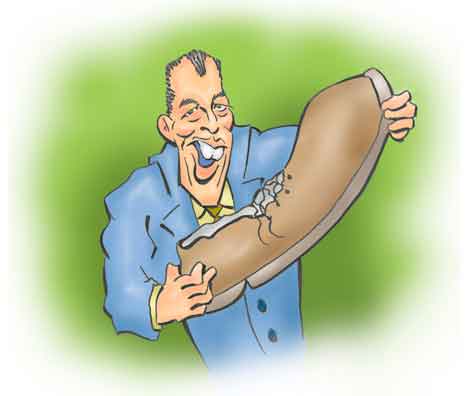
Ed Sullivan
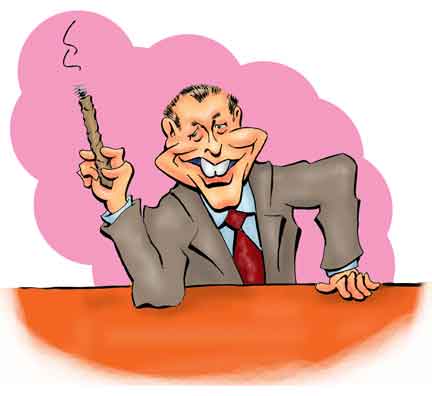
Milton Berle
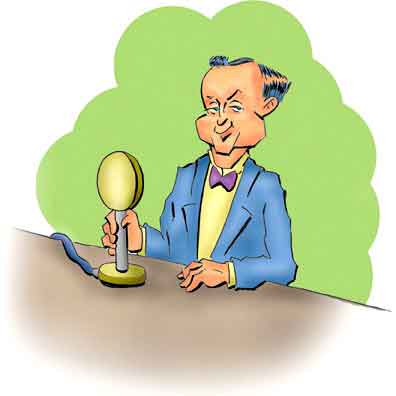
John Daly
Carl not only appeared on programs you'd expect like See It Now and Person to Person (both hosted by Edward R. Murrow), but also your workaday programs like the Today Show (hosted by Dave Garroway), the Tonight Show (with Jack Paar), and The Bell Telephone Hour. He even appeared on The Ed Sullivan Show and The Milton Berle Show for crying out loud! Then at age 82 he received thunderous applause when he was the "Mystery Guest" on the celebrity panel show What's My Line. The show was hosted by John Daly (who was the first correspondent to broadcast the news of the attack on Pearl Harbor) and actress Arlene Frances guessed Carl's identity.
Schools were named after Carl, and Galesburg opened a junior college, Carl Sandburg College (which is still going strong). He was awarded honorary degrees and was the friend of politicians of all parties including the presidents. Then on February 12, 1959, Carl addressed a joint session of Congress to celebrate the birthday of Abraham Lincoln. To this day, no private citizen has received such an honor10.
Footnote
Not that Carl was uncritical of American politics and we must admit he was partial to the Democrats. He criticized Dwight Eisenhower for his disdain of the Peace Corp, a US government program to help the poor in the world. Carl went on a rant pointing out that for all practical purposes and for his entire life Ike had effectively lived off a welfare state with clothing, housing, and education provided at the government's expense.
Carl was always in the news. During his lifetime he was mentioned more often than celebrities like Clark Gable, Marlon Brando, and even Marilyn Monroe. You even read more about Carl than Elvis, for heaven's sake! It wasn't until 1980 - after Elvis had been effectively deified - that Elvis overtook Carl in popular reference. So we have to say it was Carl who was really the King.
Mentioned More Than ..
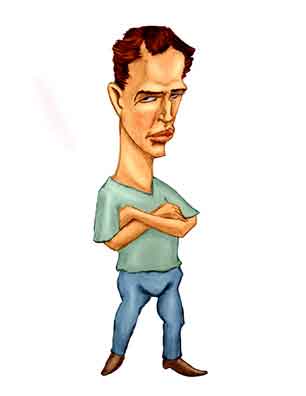
Marlon ...
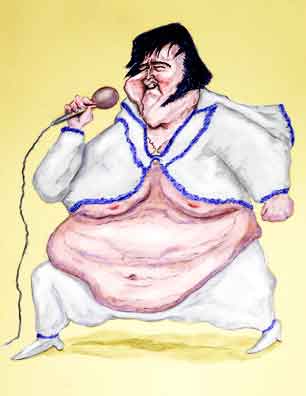
... and Elvis
Carl lived a long, prosperous, and honored life. When he won his third Pulitzer Prize he was 61 years old and had nearly another three and productive decades ahead. When Carl died in 1967 at age 89, he was one of the most recognized figures in America.
Most of Carl's books are easily obtainable and ironically the hardest volumes to find at moderate prices are The Prairie Years and The War Years. But pretty much everything else is there, either online or in easily affordable and even in electronic editions.
Sadly not all poets have fared so well. Lew Welch, whose own poetry can be seen as a rebuttal to Carl's, eventually gave up his job as an advertising copywriter to devote his life to poetry. He later moved to the Sierra Nevada Mountains, and on May 11, 1971, he walked out of his cabin and was never seen again.
References and Further Reading
Carl Sandburg: A Biography, Penelope Niven, Charles Schribner's Son, 1991.
"Carl Sandburg", Penelope Niven, American National Biography.
The Other Carl Sandburg, Philip Yannella, University Press of Mississippi, 1996.
Carl Sandburg: Biography of a Poet, Penelope Niven, Mark Nadel (Illustrator), Harcourt Children's Books (2003).
The 1919 Pulitzer Prizes", The Pulitzer Prize.
"Match Point", Newsweek, January 30, 1956, p. 56.
"Carl Sandburg", Poetry Foundation.
"Carl Sandburg", Academy of American Poets.
"Carl Sandburg: Chicago's Poet", Bill Granger, Chicago Tribune, December 18, 1994.
"At 100, Poem 'Chicago' Still Fierce, Fresh", Steve Johnson, Chicago Tribune, February 19, 2014.
"Carl Sandburg's Chicago: Stormy, Husky, Brawling at 100", Liesl Olson, Los Angeles Review of Books, July 10, 2016.
"The Poetry of Robert Frost: The Power and Intrigue of Simile", Professor Belinda Jack, Lecture, Gresham College Oxford, April 11, 2017.
"Carl Sandburg", Encyclopedia of Milwaukee.
"How Milwaukee's Famous Beer Became Infamous: The Fall of Schlitz", Martyn Cornell, Beer Connoisseur, January 10, 2010.
"Flashback: Before Chicago Erupted Into Race Riots in 1919, Carl Sandburg Reported on the Fissures", Ron Grossman, Chicago Tribune, July 18, 2019.
"Allen Ginsberg, The Art of Poetry No. 8", Thomas Clark (Interviewer), Paris Review, Issue 37, Spring 1966.
"Sandburg Family Timeline", Carl Sandburg Home, National Park Service.
The Chicago Race Riots, July, 1919, Carl Sandburg, Harcourt, Brace and Howe, 1919.
"Dynamiter Is Found Guilty By Jury After Two Ballots", Hawaiian Gazette, December 31, 1915, Page 1, Chronicling America, Library of Congress.
Clarence Darrow for the Defense, Irving Stone, Doubleday (1941, Original Edition; Reprint, Signet, 1971).
"Hallelujah", Carl Sandburg, Scott County [Missouri] Kicker, November 25, 1911, Page 5, Chronicling America, Library of Congress.
"Matthew A. Schmidt Papers, 1906-1952", Online Archive of California, (Schmidt Papers Not Available Online)
"Schmidt Convinced in Los Angeles Times Explosion", The Day Book, December 31, 1915, Page 1, Chronicling America, Library of Congress.
"Schmidt's Address to the Court After Being Convicted of Conspiracy", The Day Book, December 31, 1915, Page 28, Chronicling America, Library of Congress.
"Big Federal Men Try To Sidestep Blame In Eastland Wreck: Secretary Red Field Shows Surprising Lack of Knowledge, Solicitor Thurman Smiles About Eastland Affair and Says Olander Is Wrong Accusing Inspectors", Carl Sandburg, The Day Book, July 28, 1915, Page 1, Chronicling America, Library of Congress, University of Illinois at Urbana-Champaign Library.
"Harriet Monroe: 1860-1936", Poetry Foundation,
"Recovering Carl Sandburg: Politics, Prose, And Poetry After 1920", Evert Villarreal, Ph. D. Thesis, Texas A&M University, 2006.
"Carl Sandburg and 'Git-Tar' Make Superb Records of American Folks Songs", Life Magazine, February 21, 1938, pp/ 42-43.
"Glimpses Into Sandburg's Life: Communists, FDR and One Mystery", Patrick Reardon, Chicago Tribune, August 30, 2002.
"Bob Dylan: An Intimate Biography", Anthony Scarduto, Rolling Stone, March 16, 1972.
"Sandburg's Biography", City of the Big Shoulders: Carl Sandburg's Chicago, University of Michigan.
The Other Carl Sandburg, Philip Yannella, University Press of Mississippi, 1996.
"Sandburg's Lincoln Within History", James Hurt, Journal of the Abraham Lincoln Association, Volume 20, Issue 1, Winter 1999, pp. 55-65 (Online Reprint: University of Michigan).
To Tell the Truth, Bud Collyer, (Host), Tom Poston (Panelist), Peggy Cass (Panelist), Barry Nelson (Panelist), Kitty Carlisle (Panelist), Johnny Olson (Announcer), Hunter S. Thompson (Panelist), February 20, 1967, Internet Movie Data Base
"The Pop Art Affair", Robert Vaughn (Actor), David McCallum (Actor), Leo G. Carroll (Actor), Sherry Alberoni (Actor), Robert H. Harris (Actor), Sabrina Scharf (Actor), George Waggner (Director), Al Ramrus (Writer), Sam Rolfe (Developer), John Herman Shaner (Writer), NBC, October 21, 1966, Internet Movie Data Base.
"Diet Squad", Studs Terkel, Garrison Keillor, Les Podewell, Joe Trimback, Kate MacKenzie, Peter Ostroushko, and Butch Thompson, Red Maddock, and Bill Evans, A Prairie Home Companion, November 9, 1982, National Public Radio.
"Mending Wall", North of Boston, David Nutt, 1914.
The American Songbag, Carl Sandburg, Harcout Brace And Company, 1927.
"Five Things You Didn't Know About the Beats in Chicago", Mark Schipper, Chicago Magazine, February 7, 2017.
What's My Line?, John Daly (Presenter/Host), Dorothy Kilgallen (Panelist), Nick Adams (Panelist), Arlene Francis (Panelist), Bennett Cerf (Panelist), Carl Sandburg (Mystery Guest), Milton Berle (Panelist), Hal Simms (Announcer), September 11, 1960.
"Carl Sandburg", Internet Movie Data Base.
Chronicling America, Library of Congress.
"Carl Sandburg", Ngram Viewer.
"Elvis Presley", Ngram Viewer.
"Marlon Brando", Ngram Viewer.
"Clark Gable", Ngram Viewer.
"Ed Sullivan", Ngram Viewer.
"Marilyn Monroe", Ngram Viewer.
